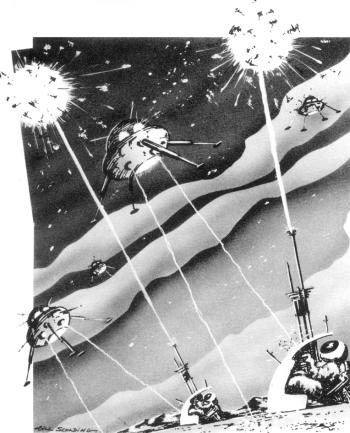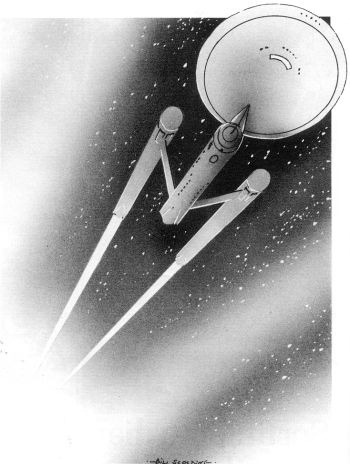| software overview |
Sorting the diamonds from the glassPhil Garratt scratches the surface of the vast number of products on the market |
 |
NO OVERVIEW of software for the Sinclair computers can hope to do more than scratch the surface of an enormous range of products now available. There are many gems among them and one or two which barely make it into the glass category. When my ZX-80 arrived nearly two years ago, it was difficult to find it mentioned in the microcomputer magazines, let alone any software. Now there are hundreds of programs available and almost as many micro magazines.
The earliest ZX-80 offerings were fairly routine - Mastermind, Simon, Nim. Ken MacDonald's Amazing Active Display, a machine code pause routine, however, showed that there was more to the ZX-80 than met the eye.
Shortly after, the first "flicker-free" games for the ZX-80 appeared, using software in exactly the way that the ZX-81 uses hardware, splitting the Z-80 microprocessor time between keeping on the display and following the program instructions.
MacDonald produced his "flicker-free" if rather eye-numbing Breakout, and John Edmonds produced a limited but recognisable Space Invaders. He also invented Galaxy Wars which, if I had no other reason, is sufficient on its own for me never to want to part with my ZX-80. It is far and away the most original and compulsive game I have either for the 80 or the 81.
Another major achievement in ZX-80 software was Philip Joy's chess program, which appeared in early 1981. Although its standard of play could perhaps best be described as "not illegal", it showed that the ZX-80 had a potential to match computers costing five times as much.
Then the ZX-81 was announced. By the time the public could obtain either the new machine or the new ROM for the ZX-80, there was already a number of books and programs available, because of the Sinclair "seeding" of some authors with machines. Sinclair introduced a range of inexpensive software, which was good at the time, though fairly routine. Its failure to add to the range in a year is a great pity.
As I indicated initially, all I can do is to try to deal with some of the ZX-81 programs available, which I will split into three groups - arcade games, other games and utilities. I have to omit any discussion of business-orientated packages as they are outside my field but it must be said that Hilderbay, with its range which includes a payroll system, is doing a marvellous public relations job for the rest of us - by showing that the Sinclair is sufficiently powerful to have a serious side.
I am also omitting household programs such as Bank Account and Telephone Directory. Although those programs are useful when trying to justify a home computer to sceptics, the ZX-81 takes too long to save and load to make them worthwhile. Now if we had discs - but that is another story.
So to arcade games, the most famous of which is Space Invaders, and the Macronics version for the 1K ZX-81 is good for the time when your 10 pence pieces run out. Incidentally, Macronics provides a listing with each cassette and it would be pleasant if other companies followed suit.
The program is a smaller version of the real thing - you have only one laser base per game and only the current and last game scores are displayed - i.e., no highest score feature. I had reservations at first but I soon became addicted, as did all the children to whom I showed it at Christmas.
They added their own sound effects of the Pchow! and Wham! variety but if I had had the necessary hardware, that would not have been required for the next two programs, Quicksilva's Defender and Asteroids. The first involves running a gauntlet of invaders coming at you from the right, while moving your ship up and down, faster and slower, trying to fire while avoiding their missiles and all the time watching the ground rush past below.
The program is remarkable in two respects. First, it includes software to drive an add-on sound generator available from Quicksilva and, although it is not cheap, it adds a new dimension to games. Second, the display uses the entire height of the TV screen - not just the portion of it addressed by the ZX-81.
Asteroids does not use the entire screen but has the sound - generating instructions. Your ship is a number on the screen, which represents the direction of movement or fire, e.g., 0 equals up, Z equals right, and the like. The larger asteroids disintegrate in a satisfying manner and more and more appear as the game progresses. Once you are used to not having an arrow to show the direction of your ship, it becomes a good game.
The last arcade game at which I look at is DKtronics Centipede. I cannot describe it adequately without confusing all and sundry, so suffice to say it has excellent moving graphics and is very attractively presented, with the game becoming progressively more difficult in several ways.
What is also very creditable about it is that the player can decide at the start how many bases each game should have and how fast the game should run. That means that several people can play at the same level of difficulty and the program produces a high score league table.
Moving to non-arcade games, a number of "adventures" are available and one of the major factors in determining the appeal of an adventure is the number of situations involved in the game. That means that machine code games such as the two Artic Computing Adventures have a big advantage over programs using Basic.
The Adventure A seems the easier of the two but Adventure B will give you a score - if you score anything - although it is much fussier about which words it will accept in each situation.

Both require plenty of time and patience, whereas the Macronics Nightmare Park is usually finished quickly. It is really eight or 10 simple Basic programs, such as Number Guessing and Simon, all joined neatly together, and which you go through at random as you try to cross the park. This well-presented game kept the children quiet for hours, too.
A number of ZX-81 versions of the classic Startrek are available - all, if anything, better than the original mainframe program. I showed the game to an 11-year-old and her comment, "Gee, it takes a million years to kill a single Klingon" is a slight exaggeration, although it is true that a game can take two hours.
I have two versions of the game, one by Macronics, which makes good use of graphics, although entering of commands has to be done carefully, and the other by Silversoft which, although a trifle slower, is better-presented.
Several chess programs exist, although the only one I have is Artic ZX chess. It plays an impressive game on six levels, the first three levels responding in less than 10 seconds, 40 seconds and five minutes respectively. Every level plays good chess but tends to lack an end-game strategy. Recently I have seen the latest version of the program, which has minor bugs corrected, although the input has been made a little more complicated.
In addition, the level one time has been reduced from 10 to two seconds and the others speeded accordingly.
Now for the utilities, which are programs to help you write programs.
The best I have seen is Bug-Bytes ZXAS assembler. It allows you to enter standard Z-80 mnemonic codes, e.g., LD HL. (16396), in REM statements, which are assembled and then placed wherever you want in memory.
It seems that many ZX-81 users are interested in machine code; the assembler makes learning and using it a hundred times easier.
Bug-Bytes also sells a disassembler, which can be used at the same time as ZXAS, and which can produce memories from machine code - e.g., the ROM - plus other facilities. The last program which I have not seen yet is ZX-MC from Picturesque, which apparently allows double-speed loading and saving of any part of the memory, among other things.
I have mentioned fewer programs than I would like and in less detail than I would like. The best thing is to see the programs run before you buy, as more and more are now available in shops. Watch for the 'cowboys' who are selling programs extracted from magazines but, in general, ZX software is good value, often providing displays and routines I would not have thought possible, and cheaper than similar programs for other computers on the market.